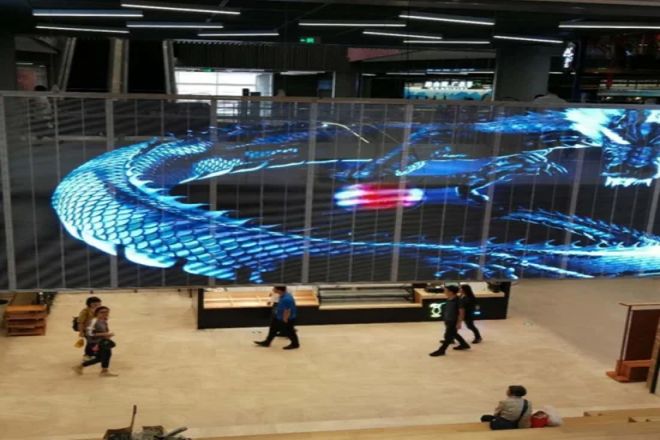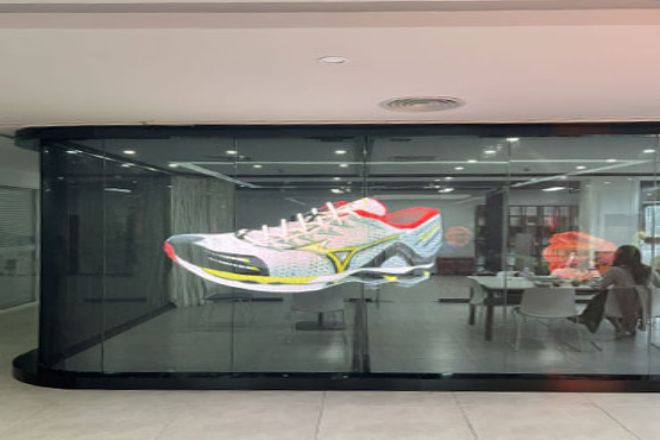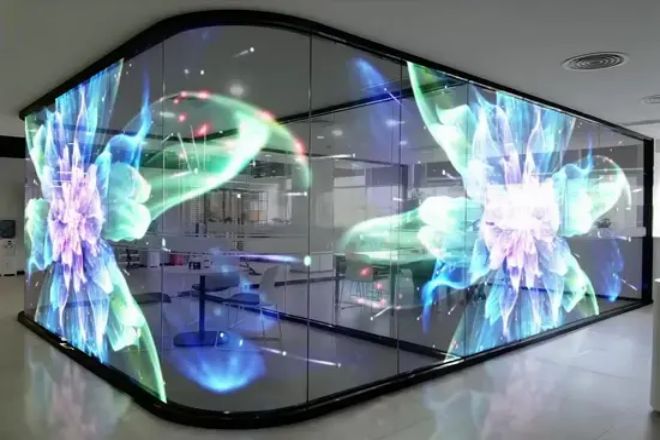介绍

在当今科技发展日新月异的世界,显示技术作为连接现实世界和虚拟世界的桥梁,正在以前所未有的速度发展。
从最初的黑白屏到彩色LCD,再到如今的OLED、Mini LED等先进技术,每一次跨越都极大地丰富了我们的视觉体验。如今,作为新一代显示技术的璀璨明珠,3D 透明LED显示屏 正在悄然改变我们对“展示”一词的理解。
它不仅突破了传统显示屏二维的限制,还以其独特的透明度和立体感为我们开启了一个全新的视觉时代。
在这个充满无限可能的时代,让我们一起踏上这场视觉探索之旅,用短短两分钟的时间,揭开3D透明LED显示屏的神秘面纱,感受其带来的前所未有的视觉震撼与创作灵感。
1、3D透明LED显示屏概述
顾名思义, 3D 透明LED显示屏是LED显示技术与透明材料创新设计相结合的显示屏。
它不仅继承了LED显示屏高亮度、高对比度、长寿命、色彩鲜艳等传统优点,还利用透明基板等特殊材料实现了屏幕本身的透明性。
这样的设计,可使屏幕在播放内容的同时,让背景风景或光线自然地穿透,营造出前所未有的视觉层次感和空间感,从而实现“透明”与“3D”效果的真正结合。
结构特点:
- LED灯珠:
作为显示屏的发光单元,3D透明LED显示屏采用了高密度的微型LED灯珠,这些灯珠不仅体积小、亮度高,还能精确控制每个像素的亮灭,从而实现细腻的图像显示。
同时,为了保持透明度,灯珠的布局和排列需要经过精心设计,以确保其在发光时不会阻挡过多的光线穿透。
- 透明基材:
透明基板是3D透明LED显示屏的核心部件之一,通常采用透光率较高的玻璃或者特殊塑料材料制成。
这种基板不仅具有良好的机械性能和稳定性,更重要的是它能让光线自由穿透,从而能清晰地显示屏幕背后的景物或光线。
通过优化基板材料与结构,可以进一步提高屏幕的通透度和视觉效果。
- 控制电路:
控制电路是3D透明LED显示屏的大脑,负责接收并处理来自外界(如电脑、手机等)的信号,将这些信息转换成LED灯珠点亮、熄灭的指令。
为了达到高清流畅的显示效果,控制电路需具备高速的数据处理能力和精准的像素控制能力,同时为了保持整体的通透性和美观度,控制电路通常采用薄型设计,隐藏在透明基板之下。
2. 核心技术亮点

- 3D显示效果
3D透明LED显示屏的3D显示效果是其最吸引眼球的核心技术亮点之一,为了实现这一效果,显示屏采用了精密的光学设计和先进的软件算法。
在光学设计方面,通过调整LED灯珠的排列密度、角度、折射、反射路径,使得屏幕在播放3D内容时能够呈现出丰富的立体层次感和纵深感。
同时结合特殊的透镜或光栅技术,可以进一步增强立体视觉效果,让观众有身临其境之感。
在软件算法方面,3D透明LED显示屏采用先进的图像处理技术,对原始图像进行深度分析处理,提取图像中的三维信息,并转换成适合屏幕显示的格式。
通过算法的优化,可以保证图像在保持高清晰度的同时,呈现出更加真实自然的3D效果,这种软硬件结合的方式,让3D透明LED显示屏在显示复杂场景、动态内容方面有着得天独厚的优势。
- 高透明度和透光率
高透明度和透光率是3D透明LED显示屏的另一大核心技术亮点,为了实现这一目标,显示屏在透明基板材料的选择和加工上下了很大的功夫。
首先基板材料需要具备良好的透光性,保证光线能够顺利穿透屏幕。市面上常用的透明基板材料有透光率较高的玻璃、特殊塑料等。
这些材料不仅具有较高的透光率,而且具有良好的力学性能和稳定性,能够满足显示屏的使用要求。
其次,在基材材料的加工工艺方面,也采用多种方法来提高透明度。
例如通过优化表面处理工艺,减少基材表面的反射与散射,进而提高光的透过率;或采用多层薄膜叠加技术,利用不同材料间的折射率差异,增强光的透射效果。
这些技术手段的应用,使3D透明LED显示屏在保持高透明度的同时,还能达到良好的视觉效果和色彩还原。
- 灵活的定制和安装
3D透明LED显示屏的模块化设计是其实现灵活定制和安装的关键,显示屏由多个独立的模块组成,每个模块内含有一定数量的LED灯珠和控制电路。
这样的设计使得显示屏可以根据实际需要灵活地进行拼接组合,以适应不同形状和尺寸的安装环境。
此外,模块化设计也带来诸多便利。
例如在安装过程中,可根据现场情况灵活调整模组的位置、数量,以达到最佳的视觉效果和安装效果;在维护时,如果某个模组发生故障或者损坏,可以单独拆除更换该模组,而不影响整个显示屏的正常运行。
这种灵活性和可维护性使得3D透明LED显示屏在大型商业显示、公共艺术装置等领域有着广阔的应用前景。
3.应用场景展示
- 商业广告
在商业领域,3D透明LED显示屏正逐渐成为各大商场、机场等人流密集区域的新宠,具有独特的视觉效果和强大的吸引力。
这些显示屏不仅能够播放高清、逼真的广告内容,更重要的是,它们能够利用自身透明的特性,将广告信息与背后的环境或景观融为一体,产生前所未有的视觉冲击力。
当顾客穿梭于这些区域时,就会被这些屏幕上精彩的画面所吸引,不由自主地驻足观看,从而有效提升了广告的传播效果和品牌形象。
此外,3D透明LED显示屏还支持动态内容更新和远程控制,让广告主可以根据市场需求、节庆气氛等灵活调整广告内容,保持广告的新鲜度和及时性。
- 艺术展览
在文化艺术领域,3D透明LED显示屏同样展现出非凡的魅力,在博物馆、美术馆等展览场所,这些显示屏巧妙地融入到艺术品的展示中,成为连接传统与现代、现实与虚拟的桥梁。
通过播放与艺术品相关的动态影像、历史背景或是创作过程,让观众在欣赏艺术品的同时,获得更加全面深入的理解与体验。更重要的是,3D透明LED显示屏的互动性,带来了一种全新的艺术展览体验方式。
观众可以通过触摸屏、手势识别等方式与屏幕进行交互,参与到艺术品的创作和展示中,享受前所未有的参与感和沉浸感。
- 智能家居
随着智能家居概念的普及和技术的不断进步,3D透明LED显示屏也开始在家居装饰、智能玻璃窗等领域展现出广泛的应用前景。
在家居装饰方面,这些显示器可以设计成各种形状和尺寸,嵌入墙面、天花板或家具中,作为室内装饰的一部分,不仅可以播放家人喜欢的音乐、视频等内容,还可以根据环境光线和氛围自动调节亮度和色彩,营造温馨舒适的生活环境。
在智能玻璃窗方面,3D透明LED显示屏可与智能控制系统结合,实现窗户的智能开合、遮阳、隔热等功能,同时还可作为信息显示平台,显示天气预报、时间日期、家居安全信息等实用信息,为家庭生活带来便捷与舒适。
这些应用不仅提高了生活质量,也展现了3D透明LED显示屏作为未来生活空间一部分的无限潜力。
4. 技术优势与挑战

1). 技术优势
- 出色的视觉效果:
3D透明LED显示屏通过精巧的光学设计和软件算法,实现立体的视觉体验,让观看者体验到更加真实、生动的画面效果。
这种独特的展示效果不仅增强了视觉冲击力,更提升了观众的沉浸感和参与感,为商业广告、艺术展览等领域带来了一种全新的展示方式。
- 节能环保:
与传统显示屏相比,3D透明LED显示屏在能耗方面具有显著优势。
由于采用了高效的LED光源和优化的电路设计,这些显示器在保持高亮度和高清晰度的同时,可以大幅降低能耗,减少对环境的影响。
此外,其透明的特性还使得屏幕在不需要显示内容的时候可以让光线穿透,进一步降低能耗。
- 安装方便:
3D透明LED显示屏采用模块化设计,使得安装过程更加灵活便捷,用户可以根据实际需要选择不同数量、不同尺寸的模块进行拼接组合,以适应各种形状、大小的安装环境。
同时这样的设计也方便后期的维护和更换工作,减少维护费用和时间成本。
2). 挑战
- 技术成熟度:
3D透明LED显示屏虽然在视觉效果和技术性能上具有显著优势,但其技术成熟度仍有待提升。
目前,市场上能够提供高品质3D透明LED显示屏的公司相对较少,技术标准和规范也尚未完全统一。这在一定程度上限制了该技术的推广和应用范围。
- 成本控制:
由于3D透明LED显示屏采用优质的材料和先进的技术工艺,其成本相对较高。这对于一些预算有限的用户来说可能是一个很大的挑战。因此,在保证质量的同时降低成本是该技术未来发展需要解决的重要问题之一。
- 内容创作:
3D透明LED显示屏的显示效果对内容创作提出了更高的要求,为了充分发挥其立体视觉优势,需要制作出高质量、高清晰度的3D内容。
但目前市面上能够提供此类内容的专业机构和人才相对较少,内容制作成本也较高,这在一定程度上限制了该技术在某些领域的应用和发展。
3). 未来发展趋势及解决方案
随着技术的不断进步和市场的不断发展,3D透明LED显示屏未来发展前景广阔。
为了克服上述挑战,实现更广泛的应用和发展,可以从以下几方面入手:
- 加强技术研发和标准化建设:
通过加大研发投入和技术创新,推动3D透明LED显示技术的不断成熟和完善。同时,加强行业内的标准化建设,制定统一的技术标准和规范,提高产品的兼容性和互换性。
- 优化成本结构:
通过规模化生产、优化生产流程、材料选择等降低生产成本。
同时,加强与供应商、合作伙伴的合作与磋商,争取更优惠的采购价格和更高效的供应链管理。
- 推动内容创作行业发展:
鼓励和支持专业机构和人才致力于3D内容创作研发创新,通过政策扶持、资金支持、培训指导等方式,激发创作热情,提升创作水平。
同时加强与影视、游戏、广告等相关行业的合作交流,共同促进3D内容创作产业的繁荣发展。
结论
随着3D透明LED显示技术的不断成熟和普及,我们有理由相信,未来的视觉世界将更加丰富多彩、生动有趣。它不仅是技术进步的象征,更是人类创造力和想象力的结晶。在这个光与影交织的梦幻舞台上,每一处细节都闪耀着智慧的光芒,每一次创新都预示着美好的未来。
最后,如果您想了解更多关于LED显示屏的知识, 请与我们联系。
